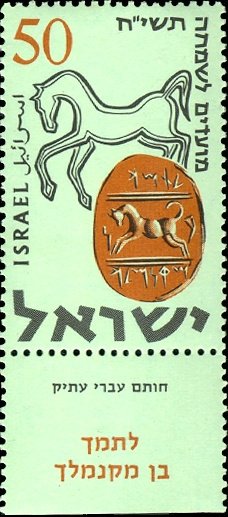Stamp with Collectible Margin: Seal of Tamach, Son of Miknemelech, and Horse (Israel 1957)
Seal of Tamach, Son of Miknemelech, and Horse (Israel 1957)
04 September (Israel ) within release Festival 1957 goes into circulation Stamp with Collectible Margin Seal of Tamach, Son of Miknemelech, and Horse face value 50 Israeli pruta
| Stamp with Collectible Margin Seal of Tamach, Son of Miknemelech, and Horse in catalogues | |
|---|---|
| Michel: | Mi: IL 145T |
| Stamp Number: | Sn: IL 129T |
| Yvert et Tellier: | Yt: IL 121T |
| Stanley Gibbons: | Sg: IL 139T |
Stamp with Collectible Margin is vertical format.
Jewish New Year (1957)Also in the issue Festival 1957:
- Stamp - Festival 1957 - Horse face value 50;
- Stamp - Festival 1957 - Lion face value 160;
- Stamp - Festival 1957 - Gazelle face value 300;
- First Day Cover - Festivals 5718 (1957) face value 510;
- Stamp with Collectible Margin - Seal of Netanyahuv Ne'avadyahu, and Gazelle face value 300;
- Stamp with Collectible Margin - Seal of Shema, Servant of Jeroboam, and Lion face value 160;
- Stamp with Collectible Margin - Seal of Tamach, Son of Miknemelech, and Horse face value 50;
- Full Pane - Seal of Netanyahuv Ne'avadyahu, and Gazelle face value 20*300;
- Full Pane - Seal of Shema, Servant of Jeroboam, and Lion face value 20*160;
- Full Pane - Seal of Tamach, Son of Miknemelech, and Horse face value 20*50;
Stamp with Collectible Margin Seal of Tamach, Son of Miknemelech, and Horse it reflects the thematic directions:
Animals are multicellular, eukaryotic organisms of the kingdom Animalia (also called Metazoa). All animals are motile, meaning they can move spontaneously and independently, at some point in their lives. Their body plan eventually becomes fixed as they develop, although some undergo a process of metamorphosis later on in their lives. All animals are heterotrophs: they must ingest other organisms or their products for sustenance.
A festival is an event celebrated by a community and centering on some characteristic aspect or aspects of that community and its religion or cultures. It is often marked as a local or national holiday, mela, or eid. A festival constitutes typical cases of glocalization, as well as the high culture-low culture interrelationship. Next to religion and folklore, a significant origin is agricultural. Food is such a vital resource that many festivals are associated with harvest time. Religious commemoration and thanksgiving for good harvests are blended in events that take place in autumn, such as Halloween in the northern hemisphere and Easter in the southern.
The horse (Equus ferus caballus) is one of two extant subspecies of Equus ferus. It is an odd-toed ungulate mammal belonging to the taxonomic family Equidae. The horse has evolved over the past 45 to 55 million years from a small multi-toed creature, Eohippus, into the large, single-toed animal of today. Humans began to domesticate horses around 4000 BC, and their domestication is believed to have been widespread by 3000 BC. Horses in the subspecies caballus are domesticated, although some domesticated populations live in the wild as feral horses. These feral populations are not true wild horses, as this term is used to describe horses that have never been domesticated, such as the endangered Przewalski's horse, a separate subspecies, and the only remaining true wild horse. There is an extensive, specialized vocabulary used to describe equine-related concepts, covering everything from anatomy to life stages, size, colors, markings, breeds, locomotion, and behavior.
The New Year is the time or day at which a new calendar year begins and the calendar's year count increments by one. Many cultures celebrate the event in some manner. In the Gregorian calendar, the most widely used calendar system today, New Year occurs on January 1 (New Year's Day, preceded by New Year's Eve). This was also the first day of the year in the original Julian calendar and the Roman calendar (after 153 BC)





